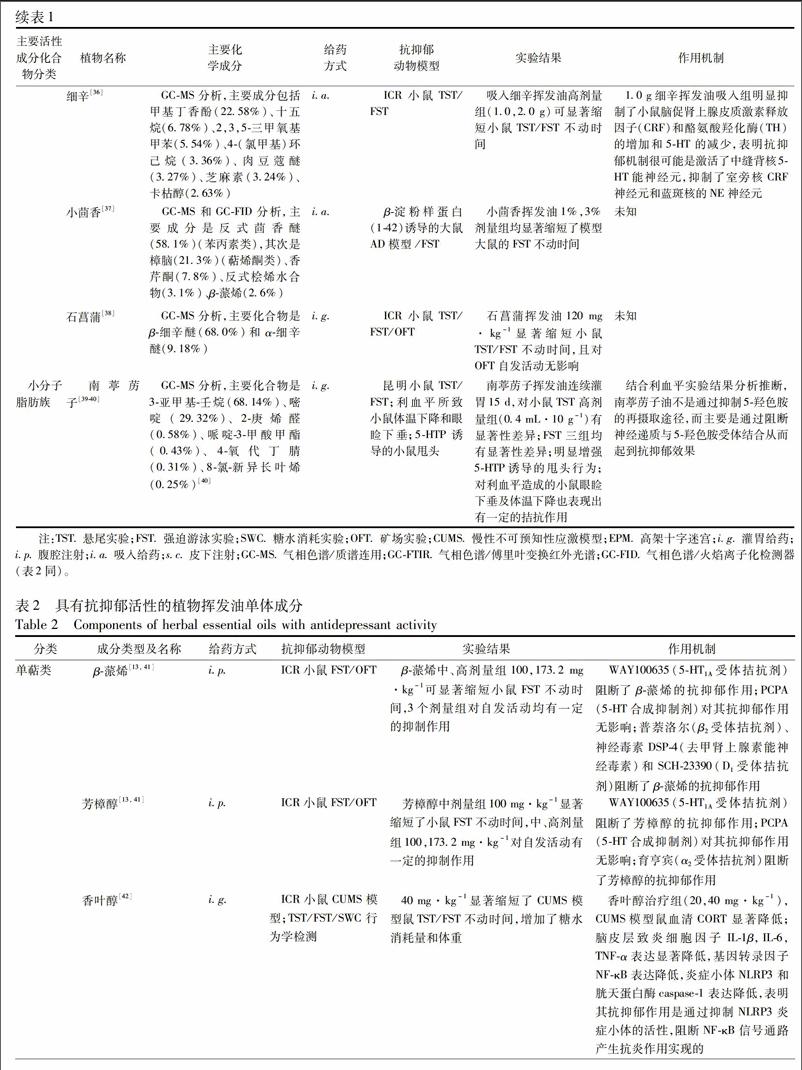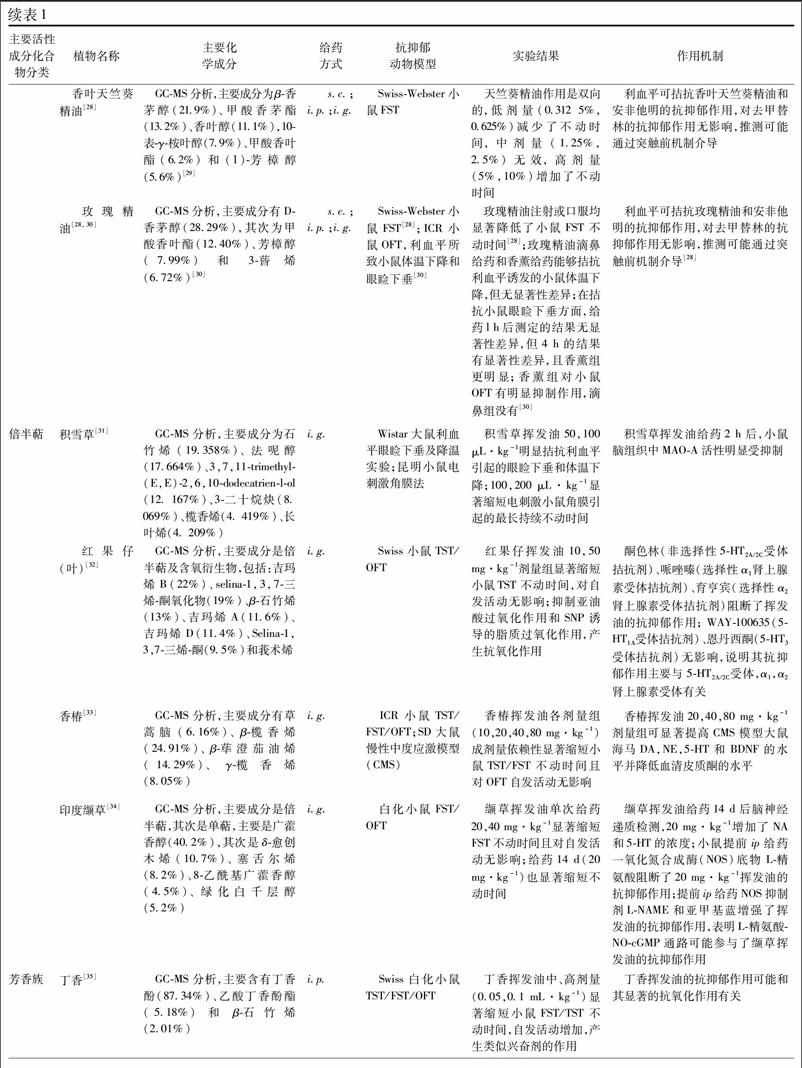植物挥发油快速起效抗抑郁潜能探讨
杜金平+刘艳庭+武艺静+吴红华+徐砚通



[摘要] 现有抗抑郁药物临床起效缓慢,因此需要研发快速起效抗抑郁药物。植物挥发油显示具有快速起效抗抑郁潜能,首先,挥发油气味芳香能够直接刺激嗅神经,脂溶性高易于透过血脑屏障,挥发性强适合鼻腔脑靶向和吸入给药,能够快速调节脑功能,具有快速起效抗抑郁潜能;其次,抗抑郁活性植物挥发油化学和药理研究进展揭示了挥发油抗抑郁化学物质基础、抗抑郁效果及可能作用機制;再者,考察植物挥发油抗抑郁活性成分对快速起效抗抑郁靶点作用,发现植物挥发油化学成分能拮抗NMDA受体活性,提示植物挥发油具有快速起效抗抑郁靶点机制潜能;最后,探讨通过整合抗抑郁挥发油特性、快速起效抗抑郁靶点机制和给药方式,充分发挥植物挥发油快速起效抗抑郁优势,为新药研发提供方向。
[关键词] 植物; 挥发油; 快速; 抗抑郁
[Abstract] The existing antidepressants demonstrated delayed onset of clinical effects, so fast-onset antidepressants are required. Essential oil of herbs showed potentials fast-onset antidepressant potential. First, its aromatic odor can directly activate olfactory nerves; its high lipophilicity causes a high blood-brain barrier penetration rate; and its high volatility is suitable for nasal-brain targeting and inhalation delivery. Therefore, essential oils can rapidly regulate brain functions by multiple ways, suggesting a fast-onset antidepressant potential. Second, the advance of studies on chemistry and pharmacology of antidepressant essential oils demonstrated chemical substances, antidepressant effects and possible action mechanisms of antidepressant essential oils. Third, the effect of essential oils′ antidepressant components on fast-onset antidepressant targets was investigated. It was found that chemical constituents of essential oils antagonized NMDA receptor activities, suggesting that essential oils have fast-onset antidepressant effect. Finally, characteristics of essential oils, fast-onset antidepressant targets and drug delivery methods are integrated to give full play to essential oils′ fast-onset antidepressant advantage and provide a new direction for new drug discovery.
[Key words] herb; essential oil; fast-onset; antidepressant
现有抗抑郁药物临床起效缓慢,如三环类药物(TCAs)、单胺转运体抑制剂(MTIs)和单胺氧化酶抑制剂(MAOIs)等,需要持续给药至少3~6周时间,既影响患者治疗依从性,又不能及时控制重症抑郁症患者致残和自杀危险[1-2],因此临床亟需快速起效抗抑郁药物。目前快速起效抗抑郁药物发现采用经典的药物靶点筛选方法,有别于传统抗抑郁药物靶点如单胺氧化酶(MAO)和单胺转运体(MTs),快速起效抗抑郁药物作用于新靶点,这些靶点根据起效时间可分为快速和中速两类,快速起效抗抑郁药物靶点为NMDA受体,起效时间在数小时内,代表性药物如氯胺酮;中速起效靶点包括乙酰胆碱M受体、5-HT2C受体、5-HT4受体、5-HT7受体、TrkB受体等,起效时间在7 d内,代表性药物如东莨菪碱、RS 102221、BDNF等[1]。
根据快速起效抗抑郁药物研究进展[1],结合植物挥发油理化特性和给药途径,本文提出植物挥发油具有快速起效抗抑郁潜能,对此从以下4个方面进行分析和论证。
1 植物挥发油能够快速调节脑功能
挥发油是一类具有芳香气味的油状液体总称,在常温下能挥发,可随水蒸气蒸馏[3]。植物挥发油气味芳香能够直接刺激嗅神经快速调节脑功能;脂溶性高易于通过血脑屏障,克服了诸多药物难于入脑的问题[4];挥发性强适合鼻腔给药和吸入给药[5],这些特征提示植物挥发油具有快速起效抗抑郁潜能。
2 植物挥发油具有显著抗抑郁效果
挥发油植物来源广泛,尤其在芸香科、伞形科、姜科、菊科常见,多以油滴状态存在于植物表皮的腺毛、油室、油细胞或油管中。挥发油化学成分复杂,主要包括萜类化合物(如单萜、倍半萜及其氧化产物)、芳香族化合物和脂肪族化合物,此外,少数挥发油还存在一些薁类化合物和含硫化合物等[3]。目前植物挥发油抗抑郁研究可以归纳为挥发油提取物和挥发油化学成分2类。挥发油提取物是指将总挥发油作为有效部位进行研究,其中包含多种化学成分,能够较好代表原植物化学特征,符合多成分作用于多靶点方式,但存在化学成分不够清晰,样品难于质量控制,作用机制难于深入研究的不足之处。挥发油化学成分是指挥发油中单体化学成分,主要包括萜类和芳香族,分子结构明确,有利于质量控制和药理作用机制研究,不足之处在于其难于反映原植物化学特征,且因其沸点低、易挥发等特点较难制备获得或保存。两类研究各具特色,研究结论可以相互印证。植物挥发油提取物(表1)和化学成分(表2)抗抑郁研究的化学和药理研究进展归纳总结如下。
从植物挥发油抗抑郁化学物质基础看,在植物挥发油提取物(表1)中,主要化学成分按相对含量>60%标准确定,发现以萜类化合物为主要成分的植物包括17种,其中单萜类13种,倍半萜类4种,数量占绝对优势;以芳香族化合物为主要成分的植物包括4种;以小分子脂肪族化合物为主要成分的植物包括1种。这些植物挥发油提取物虽然证实具有抗抑郁活性,但由于提取物中含有多种化学成分,需要進一步确定其中活性成分。在植物挥发油化学成分中(表2),萜类成分包括10个,其中单萜6个,倍半萜4个;芳香族化合物5个。虽然目前报道的抗抑郁活性植物挥发油化学成分数量有限,但已经证实了植物挥发油化学成分抗抑郁作用,更多挥发油化学成分有待进一步考察。在具有抗抑郁活性挥发油化学成分中,存在相同化学成分见于多种植物提取物中的现象,如单萜类活性成分β-蒎烯,可见于柠檬、肉豆蔻、虎皮楠叶和迷迭香中;芳樟醇可见于薰衣草、鼠尾草、芫荽、虎皮楠叶、香叶天竺葵和迷迭香中;香叶醇可见于迷迭香、香叶天竺葵精油、玫瑰精油、柠檬草、鼠尾草中;柠檬烯可见于柠檬、柠檬叶、佛手、巴西胡椒果和紫苏中。这一方面提示一种活性成分存在多种植物来源,便于扩大药源;另一方面提示一种活性成分可以作为多种植物活性标识物,说明其抗抑郁活性化学物质基础。综合表1和表2化学研究内容可见,挥发油化学成分和挥发油提取物间抗抑郁活性能够相互印证,因此挥发油活性成分既可以作为挥发油提取物的活性标识成分用于质量控制,又利于深入开展药理作用机制研究工作。根据化学大类成分看,具有抗抑郁活性的植物挥发油成分化学类型特征明显,集中在萜类和芳香族化合物。这些抗抑郁活性化合物可以作为新药发现的先导化合物,进行结构修饰或合成来优化活性分子结构,用于新药研发工作。在植物挥发油化学物质基础方面,目前存在的主要问题是,虽然具有抗抑郁活性的挥发油提取物经化学分析已经确定了多数主要化学成分,但挥发油化学成分抗抑郁研究数量有限,因此有必要对挥发油提取物主要化学成分进行系统抗抑郁评价,为研发抗抑郁新药提供基础。
从植物挥发油抗抑郁活性看,无论植物挥发油提取物还是化学成分,均在多种抗抑郁动物模型上显示了抗抑郁效果。这些动物模型既包括经典初筛模型如强迫游泳(FST)[56]、悬尾(TST)[57]和旷场(OFT)[58]实验,又包括公认度很高的慢性不可预知温和应激模型(CUMS)[59],此外还有嗅球摘除模型(OBX)和利血平药物诱导模型等[60-61],表明植物挥发油抗抑郁活性确切可靠。此外,临床实验证实薰衣草挥发油胶囊(Lasea)治疗后显著降低了HAMD评分[62],乳香精油吸入配合灸法疗效与氟西汀治疗HAMD评分无显著性差异[63],为挥发油抗抑郁疗效进一步提供了临床证据。从植物挥发油抗抑郁机制看,现有研究内容系统性有待进一步提高,这与目前抑郁症发生病理生理机制认识存在多种假说有关。根据现有抗抑郁机制研究内容可以看出,有些研究立足经典单胺类神经递质假说[64-66],有些研究立足应激诱发下丘脑-垂体-肾上腺皮质轴(HPA)假说[67],有些研究立足神经可塑性假说[68],有些研究立足免疫因子假说[69],这些研究内容提示植物挥发油具有多系统活性,能够协同发挥抗抑郁效果。现有研究内容显示植物挥发油抗抑郁机制研究对于药物作用靶点环节缺失,多数研究停留在药效评价方面,即使是多层面的药效评价体系,也难于深入系统揭示活性成分的抗抑郁机制,这方面研究工作有待深入。总体而言,目前植物挥发油抗抑郁研究局限在证明药效方面,从快速起效抗抑郁角度研究尚未见报道,未能充分体现植物挥发油快速抗抑郁潜能。例如,从给药途径看,现有研究工作多数采用了灌胃和腹腔注射方式,这些给药方式虽然能够验证植物挥发油抗抑郁活性,但没有体现出植物挥发油特性和优势。有些研究工作采用了吸入给药方式,验证了挥发油抗抑郁效果[4],但这些研究工作未关注给药方式对药物起效速度影响,有待于进一步考察。
3 植物挥发油化学成分与快速抗抑郁靶点存在相互作用
为了探讨植物挥发油快速起效抗抑郁机制,基于已报道快速起效抗抑郁靶点[1],考察抗抑郁活性挥发油化学成分潜在快速起效作用。谷氨酸NMDA受体拮抗剂是目前公认的快速长效抗抑郁药物。临床前动物实验证实,NMDA受体活性化合物包括:①非竞争性NMDA受体离子通道阻断剂,如氯胺酮、MK-801和CPP;②选择性NMDA受体NR2B亚基拮抗剂,如Ro 25-6981,CP-101,606;③NMDA受体甘氨酸位点激动剂,如GLYX-13,均证实具有快速长效抗抑郁效果[1]。临床研究证实单次静脉输注低于麻醉剂量的氯胺酮在2 h内起效,疗效可持续至7 d[70]。选择性NMDA受体亚基NR2B拮抗剂CP-101,606单次静脉注射后迅速起效并持续至少7 d时间[71]。因此,基于NMDA受体发现快速起效抗抑郁药物具有坚实基础。
经文献整理发现,抗抑郁活性的植物挥发油化学成分显示了NMDA受体拮抗剂活性,目前已报道的包括单萜类芳樟醇和芳香族α-细辛醚、β-细辛醚、丁香酚、甲基丁香酚。放射性配体竞争结合实验是考察药物与靶点直接相互作用的经典方法,芳樟醇能够剂量依赖地竞争性抑制3H-谷氨酸结合[IC50为(0.57±0.05) mmol·L-1][72],但剂量依赖地非竞争性抑制3H-MK801结合(IC50为2.97 mmol·L-1)[73],证实芳樟醇能够直接与NMDA受体相互作用但具体作用位点有待进一步确定。在生物活性方面,芳樟醇具有镇痛[73-74]、抑制NMDA诱导惊厥和戊四唑点燃癫痫[72]、损伤记忆获得[75]等活性。α-细辛醚和β-细辛醚能够剂量依赖地特异抑制3H-MK801结合,表明它们能够直接作用于NMDA受体离子通道内MK801结合位点。在生物活性方面,α-细辛醚和β-细辛醚能够在原代培养大鼠皮层神经元上剂量依赖地抑制谷氨酸和NMDA诱导的神经毒性[76]。丁香酚和甲基丁香酚与NMDA受体相互作用来源于间接证据,研究证实丁香酚在原代培养大鼠皮层神经元细胞上能够对抗NMDA受体诱导的损伤,抑制NMDA受体诱导的Ca2+增高,证实丁香酚具有神经保护作用[77]。甲基丁香酚能够抑制椎管注射NMDA所诱发的疼痛相关行为[78],虽然丁香酚和甲基丁香丁香酚能够对抗NMDA受体效应,但它们与NMDA受体是否存在直接相互作用有待进一步证实。对于中速起效靶点包括乙酰胆碱M受体、5-HT2C受体、5-HT4受体、5-HT7受体、TrkB受体,经文献查证未发现具有抗抑郁活性的植物挥发油化学成分与这些靶点直接相互作用的报道。目前为止,具有抗抑郁活性的植物挥发油化学成分已被证实与快速起效抗抑郁靶点NDMA受体存在直接相互作用,虽然原始文献研究内容不是抗抑郁研究,但是提示这些化学成分具有快速长效抗抑郁潜能,值得进一步考察研究。
4 优势组合提高临床起效速度
为了实现快速起效抗抑郁目标,可以将挥发油理化特性、快速起效抗抑郁靶点机制和给药途径综合考虑,充分发挥植物挥发油各方面特长,例如,将具有快速起效抗抑郁靶点活性挥发油成分通过鼻腔脑靶向/吸入给药,实现植物挥发油快速起效效应最大化。
在此对植物挥发油鼻腔给药和吸入给药进行探讨。鼻腔给药能够通过4条途径调节快速调节脑功能[79]。第1条途径是嗅神经。挥发油芳香气味激活嗅神经,通过嗅觉系统快速调节脑功能。第2条途径是三叉神经,鼻腔有三叉神经分支分布,通过三叉神经系统来调节脑功能是又一快捷通道。第3条途径是血液循环通路。药物既可以通过鼻腔动脉进入体循环,又可以通过鼻腔静脉逆流转移至颈动脉,血管周围通道也是药物进入脑内的重要途径。第4条途径是脑脊液和淋巴循环。连接蛛网膜下腔脑脊液-嗅神经周围空隙-鼻腔淋巴通路是药物经鼻腔进入脑内又一条通路,可见鼻腔-脑靶向给药涉及多种途径,是一个复杂过程[80]。鼻腔给药明显不足之处是载药量受限,且不适合频繁给药。吸入给药是植物挥发油又一种优势给药方式,药物主要经肺吸收进入体循环,通过血脑屏障进入中枢神经系统,部分药物可以经过鼻腔给药途径进入脑部[5],但不如鼻腔给药脑靶向优势明显,吸入给药载药量大于鼻腔给药。总之,这2种给药方式均能够同时启动多条快速调节脑功能途径,体现了挥发油特色,在設计药物给药途径和药物制剂时应充分发挥其特长。
5 结论
本文针对现有抗抑郁药物临床起效缓慢问题,提出植物挥发油具有快速起效抗抑郁潜能,通过四方面内容分析和论证,指出基于挥发油理化特性,结合快速起效抗抑郁靶点机制,采用挥发油特色给药途径,从抗抑郁活性植物挥发油中研发快速起效抗抑郁新药是一个值得重视的研究新方向。
[参考文献]
[1] 黄吉生,杜金平,徐砚通.快速起效抗抑郁药物研究进展[J].中国新药杂志,2015(23):2669.
[2] 瞿伟,谷珊珊.抑郁症治疗研究新进展[J].第三军医大学学报,2014,36(11):1113.
[3] 吴立军.天然药物化学[M].6版.北京:人民卫生出版社,2012:264.
[4] 许慧,徐金勇,李光武.芳香物质经嗅觉通路防治抑郁症实验进展[J].实用中医药杂志,2013,29(5):412.
[5] 陈柏君.浅论吸入给药[J].云南中医学院学报,2009,32(5):63.
[6] 佟棽棽.迷迭香和柠檬草的挥发性成分及其抗抑郁、抑菌作用的研究[D].上海:上海交通大学,2009.
[7] Machado D G,Cunha M P,Neis V B,et al. Antidepressant-like effects of fractions, essential oil, carnosol and betulinic acid isolated from Rosmarinus officinalis L[J]. Food Chem, 2013, 136(2): 999.
[8] 牛利华,胡庆东,徐金勇,等.薰衣草经嗅觉通路吸入对小鼠抑郁样行为改变及其作用机制初步探讨[J].环境与健康杂志,2010,27(10):861.
[9] Hritcu L,Cioanca O,Hancianu M. Effects of lavender oil inhalation on improving scopolamine-induced spatial memory impairment in laboratory rats[J]. Phytomedicine, 2012, 19(6): 529.
[10] Seol G H,Shim H S,Kim P J,et al. Antidepressant-like effect of Salvia sclarea is explained by modulation of dopamine activities in rats[J]. J Ethnopharmacol, 2010, 130(1): 187.
[11] 蔡继宝,林平,桑文强,等.精油中挥发性成分GC/FTIR与GC/MS联合分析[J].光谱学与光谱分析,2005,25(10):1599.
[12] Cioanca O,Hritcu L,Mihasan M,et al. Inhalation of coriander volatile oil increased anxiolytic-antidepressant-like behaviors and decreased oxidative status in beta-amyloid (1-42) rat model of Alzheimer′s disease[J]. Physiol Behav, 2014, 131(8): 68.
[13] Guzmán-Gutiérrez S L,Gómez-Cansino R,García-Zebadúa J C,et al. Antidepressant activity of Litsea glaucescens essential oil: identification of β-pinene and linalool as active principles[J]. J Ethnopharmacol, 2012, 143(2): 673.
[14] Hyangsook Choi,Song H S,Hiroyuki Ukeda A,et al. Radical-scavenging activities of citrus essential oils and their components:detection using 1,1-diphenyl-2-picrylhydrazyl[J]. J Agric Food Chem, 2000, 48(9): 4156.
[15] Kabir M,Rizkalla S W,Champ M,et al. Lemon oil vapor causes an anti-stress effect via modulating the 5-HT and DA activities in mice[J]. Behav Brain Res, 2006, 172(2): 240.
[16] Hao C W,Lai W S,Ho C T,et al. Antidepressant-like effect of lemon essential oil is through a modulation in the levels of norepinephrine, dopamine, and serotonin in mice: use of the tail suspension test[J]. J Funct Foods, 2013, 5(1): 370.
[17] LML C,Gonalves E S C,De Almeida A A,et al. Sedative, anxiolytic and antidepressant activities of citrus limon (Burn) essential oil in mice[J]. Pharmazie, 2011, 66(8): 623.
[18] 蘆红,吴月霞,杨丽嘉,等.川佛手提取物对小鼠的抗抑郁作用[J].郑州大学学报:医学版, 2011, 46(2): 220.
[19] 高洪元,田青.佛手挥发油的抗抑郁作用机制探讨[J].中国实验方剂学杂志,2012,18(7): 231.
[20] Kim K N,Ko Y J,Yang H M,et al. Anti-inflammatory effect of essential oil and its constituents from fingered citron (Citrus medica L. var. sarcodactylis ) through blocking JNK, ERK and NF-κB signaling pathways in LPS-activated RAW 264.7 cells[J]. Food Chem Toxicol, 2013, 57: 126.
[21] Piccinelli A C,Santos J A,Konkiewitz E C,et al. Antihyperalgesic and antidepressive actions of (R)-(+)-limonene, α-phellandrene, and essential oil from fruits in a neuropathic pain model[J]. Nutr Neurosci, 2015, 18(5): 217.
[22] Richter R,Reu S H V,Konig W A. Spirocyclopropane-type sesquiterpene hydrocarbons from Schinus terebinthifolius Raddi[J]. Phytochemistry, 2010, 71(11/12): 1371.
[23] Yi L T,Li J,Geng D,et al. Essential oil of Perilla frutescens -induced change in hippocampal expression of brain-derived neurotrophic factor in chronic unpredictable mild stress in mice[J]. J Ethnopharmacol, 2013, 147(1): 245.
[24] Ji Wei-Wei,Li Rui-Peng,Li Meng ,et al. Antidepressant-like effect of essential oil of Perilla frutescens in a chronic, unpredictable, mild stress-induced depression model mice[J]. Chin J Nat Med, 2014, 12(10): 753.
[25] 林硕,邵平,马新,等.紫苏挥发油化学成分GC/MS分析及抑菌评价研究[J].核农学报,2009(3):477.
[26] 卢金清,李雨玲,李婷,等. 肉豆蔻挥发油化学成分的GC-MS分析[J]. 西北药学杂志, 2012, 27(3): 202.
[27] 孙婷婷. 肉豆蔻挥发油抗抑郁作用及机制研究[D]. 郑州:河南中医学院,2014.
[28] Zarghami M,Farzin D,Khalaj L. Evaluation of antidepressant activities of rose oil and geranium oil in the mouse forced-swim test[J]. Behav Pharmacol, 2005, 16(Supplement 1):42.
[29] Maher B,Simmonds M S J,Sami S,et al. Chemical composition and biological activities of polar extracts and essential oil of rose-scented geranium, Pelargonium graveolens[J]. Phytother Res, 2013, 27(8): 1206.
[30] 應丽亚. 玫瑰精油化学成分及其功能性研究[D]. 杭州:浙江大学, 2012.
[31] 秦路平,丁如贤,张卫东,等. 积雪草挥发油成分分析及其抗抑郁作用研究[J]. 第二军医大学学报, 1998, 19(2): 186.
[32] Victoria F N,Brahm A D S,Savegnago L,et al. Involvement of serotoninergic and adrenergic systems on the antidepressant-like effect of E. uniflora L. leaves essential oil and further analysis of its antioxidant activity[J]. Neurosci Lett, 2013, 544(24): 105.
[33] Duan D,Chen L,Yang X,et al. Antidepressant-like effect of essential oil isolated from Toona ciliata Roem. var. yunnanensis[J]. J Nat Med, 2015, 69(2): 191.
[34] Sah S P,Mathela C S,Chopra K. Involvement of nitric oxide (NO) signalling pathway in the antidepressant activity of essential oil of Valeriana wallichii Patchouli alcohol chemotype[J]. Phytomedicine, 2011, 18(14): 1269.
[35] Mehta A K,Halder S,Khanna N,et al. The effect of the essential oil of Eugenia caryophyllata in animal models of depression and locomotor activity[J]. Nutr Neurosci, 2013, 16(5):233.
[36] Park H J,Lim E J,Rong J Z,et al. Effect of the fragrance inhalation of essential oil from Asarum heterotropoides on depression-like behaviors in mice[J]. BMC Complement Alternat Med, 2015, 15(1): 1.
[37] Cioanca O,Hancianu M,Mircea C,et al. Essential oils from Apiaceae as valuable resources in neurological disorders: Foeniculi Vulgare Aetheroleum[J]. Ind Crops Prod, 2016, 88: 51.
[38] Han P,Han T,Peng W,et al. Antidepressant-like effects of essential oil and asarone, a major essential oil component from the rhizome of Acorus tatarinowii[J]. Pharm Biol, 2013, 51(5): 589.
[39] 陶桓晟,罗霞,杨志荣,等.南葶苈子油抗抑郁作用的初步研究[J].四川大学学报:自然科学版, 2008, 45(1): 185.
[40] 弓建红,张艳丽,匡海学,等. GC-MS分析南葶苈子挥发油成分的研究[J].世界科学技术——中医药现代化, 2014(9):1942.
[41] Guzmán-Gutiérrez S L,Bonilla-Jaime H,Gómez-Cansino R,et al. Linalool and β-pinene exert their antidepressant-like activity through the monoaminergic pathway[J]. Life Sci, 2015, 128: 24.
[42] Deng X Y,Xue J S,Li H Y,et al. Geraniol produces antidepressant-like effects in a chronic unpredictable mild stress mice model[J]. Physiol Behav, 2015, 152(Pt A): 264.
[43] Ww J,Sy W,Zq M,et al. Effects of perillaldehyde on alternations in serum cytokines and depressive-like behavior in mice after lipopolysaccharide administration[J]. Pharmacol Biochem Behav, 2014, 116(1): 1.
[44] Ito N,Nagai T,Oikawa T,et al. Antidepressant-like effect of l-perillaldehyde in stress-induced depression-like model mice through regulation of the olfactory nervous system[J]. Evid Based Complement Alternat Med, 2011,doi:10.1093/ecam/nen045.
[45] Oshima Y,Matsuoka S,Ohizumi Y. Antidepressant principles of Valeriana fauriei roots[J]. Chem Pharm Bull (Tokyo), 1995, 43(1): 169.
[46] Bahi A,Al Mansouri S,Al Memari E,et al. beta-Caryophyllene, a CB2 receptor agonist produces multiple behavioral changes relevant to anxiety and depression in mice[J]. Physiol Behav, 2014, 135: 119.
[47] 徐金勇,李光武,蔡榮凤,等.丁香酚吸入调节小鼠抑郁样行为及其机制探讨[J].中国神经精神疾病杂志,2009,35(7):422.
[48] Norte M C,Cosentino R M,Lazarini C A. Effects of methyl-eugenol administration on behavioral models related to depression and anxiety, in rats[J]. Phytomedicine, 2005, 12(4): 294.
[49] 荣华,董海影,张静艳,等. β-细辛醚对抑郁模型大鼠海马CA3区超微结构的改变及脑组织ERK蛋白表达的影响[J].中国医学创新, 2013(36): 10.
[50] 赵春明,张晓杰,董海影,等. β-细辛醚对抑郁模型大鼠行为及海马MKP-1,MSK-1,CREB和Bcl-2的影响[J].中国实验方剂学杂志,2013,19(16):272.
[51] 王志恒,张晓杰,韩丽君. β-细辛醚对抑郁症模型大鼠海马区bcl-2的影响[J].临床军医杂志, 2013,41(4): 329.
[52] 王俊苹,董海影,赵春明,等. β-细辛醚对抑郁模型大鼠行为及生物钟基因表达的影响[J].中国实验方剂学杂志,2015,21(2):170.
[53] 高志影,张春,董海影,等.石菖蒲有效成分对抑郁模型大鼠海马神经元的保护作用[J].中国老年学杂志,2014,34(4):1000.
[54] 王艳梅.香草醛吸嗅改善C57小鼠抑郁样行为及其机制的探索[D].合肥:安徽医科大学, 2013.
[55] 许慧.香兰素吸嗅干预大鼠抑郁样行为及脑内BDNF、血清Mg2+的研究[D].合肥:安徽医科大学,2014.
[56] Porsolt R D,Pichon M L,Jalfre M. Depression: a new animal model sensitive to antidepressant treatment[J]. Nature, 1977, 266(5604): 730.
[57] Steru L,Chermat R,Thierry B,et al. The tail suspension test: a new method for screening antidepressants in mice[J]. Psychopharmacology, 1985, 85(3): 367.
[58] 王琼,买文丽,李翊华,等.自主活动实时测试分析处理系统的建立与开心散安神镇静作用验证[J].中草药,2009,40(11):1773.
[59] Willner P. Validity, reliability and utility of the chronic mild stress model of depression: a 10-year review and evaluation[J]. Psychopharmacology, 1997, 134(4): 319.
[60] Ponzio F,Achilli G,Calderini G,et al. Depletion and recovery of neuronal monoamine storage in rats of different ages treated with reserpine[J]. Neurobiol Aging, 1984, 5(2): 101.
[61] 陈红霞,张黎明,薛瑞,等.大鼠嗅球切除抑郁症动物模型的改进与评价[J].中国药理学通报, 2011, 27(3): 436.
[62] Fiβler M,Quante A. A case series on the use of lavendula oil capsules in patients suffering from major depressive disorder and symptoms of psychomotor agitation, insomnia and anxiety[J]. Complement Ther Med, 2014, 22(1): 63.
[63] 刘瑶,乔瑜,李玲,等.芳香疗法配合灸法治疗抑郁症临床研究[J].实用中医药杂志,2009, 25(4): 213.
[64] Bunney W E,Davis J M. Norepinephrine in depressive reactions. A review[J]. Arch Gen Psychiatry, 1965, 13(6): 483.
[65] Coppen A,Shaw D M,Malleson A. Changes in 5-hydroxytryptophan metabolism in depression[J]. Br J Psychiatry, 1965, 111(470): 105.
[66] Andersen H,Braestrup C,Randrup A. Apomorphine-induced stereotyped biting in the tortoise in relation to dopaminergic mechanisms[J]. Brain Behav Evol, 1975, 11(5/6): 365.
[67] Catalán R,Gallart J M,Castellanos J M,et al. Plasma corticotropin-releasing factor in depressive disorders[J]. Biol Psychiatry, 1998, 44(1): 15.
[68] Duman R S,Malberg J,Thome J. Neural plasticity to stress and antidepressant treatment[J]. Biol Psychiatry, 1999, 46(9): 1181.
[69] M M,E V,R R,et al. Increased serum interleukin-1-receptor-antagonist concentrations in major depression[J]. J Affect Disord, 1996, 36(1/2): 29.
[70] Berman R M,Cappiello A,Anand A,et al. Antidepressant effects of ketamine in depressed patients[J]. Biol Psychiatry, 2000, 47(4): 351.
[71] Preskorn S H,Baker B,Kolluri S,et al. An innovative design to establish proof of concept of the antidepressant effects of the NR2B subunit selective N-methyl-D-aspartate antagonist, CP-101,606, in patients with treatment-refractory major depressive disorder[J]. J Clin Psychopharmacol, 2008, 28(6): 631.
[72] Elisabetsky E,Brum L F S,Souza D O. Anticonvulsant properties of linalool in glutamate-related seizure models[J]. Phytomedicine, 1999, 6(6): 107.
[73] Brum L F,Elisabetsky E,Souza D. Effects of linalool on[(3)H]MK801 and[(3)H]muscimol binding in mouse cortical membranes[J]. Phytother Res, 2001, 15(5): 422.
[74] Peana A T,Marzocco S,Popolo A,et al. (-)-Linalool inhibits in vitro NO formation: probable involvement in the antinociceptive activity of this monoterpene compound[J]. Life Sci, 2006, 78(7): 719.
[75] Coelho V R,Gianesini J,Von Borowski R,et al. (-)-Linalool, a naturally occurring monoterpene compound, impairs memory acquisition in the object recognition task, inhibitory avoidance test and habituation to a novel environment in rats[J]. Phytomedicine, 2011, 18(10): 896.
[76] Cho J,Kim Y H,Kong J Y,et al. Protection of cultured rat cortical neurons from excitotoxicity by asarone, a major essential oil component in the rhizomes of Acorus gramineus[J]. Life Sci, 2002, 71(5): 591.
[77] Wie M B,Won M H,Lee K H,et al. Eugenol protects neuronal cells from excitotoxic and oxidative injury in primary cortical cultures[J]. Neurosci Lett, 1997, 225(2): 93.
[78] Yano S,Suzuki Y,Yuzurihara M,et al. Antinociceptive effect of methyleugenol on formalin-induced hyperalgesia in mice[J]. Eur J Pharmacol, 2006, 553(1/3): 99.
[79] Dhuria S V,Hanson L R,Frey W H. Intranasal delivery to the central nervous system: Mechanisms and experimental considerations[J]. J Pharm Sci, 2010, 99(4): 1654.
[80] Kozlovskaya L,Aboukaoud M,Stepensky D. Quantitative analysis of drug delivery to the brain via nasal route[J]. J Control Release, 2014, 189(36): 133.
[責任编辑 张宁宁]

